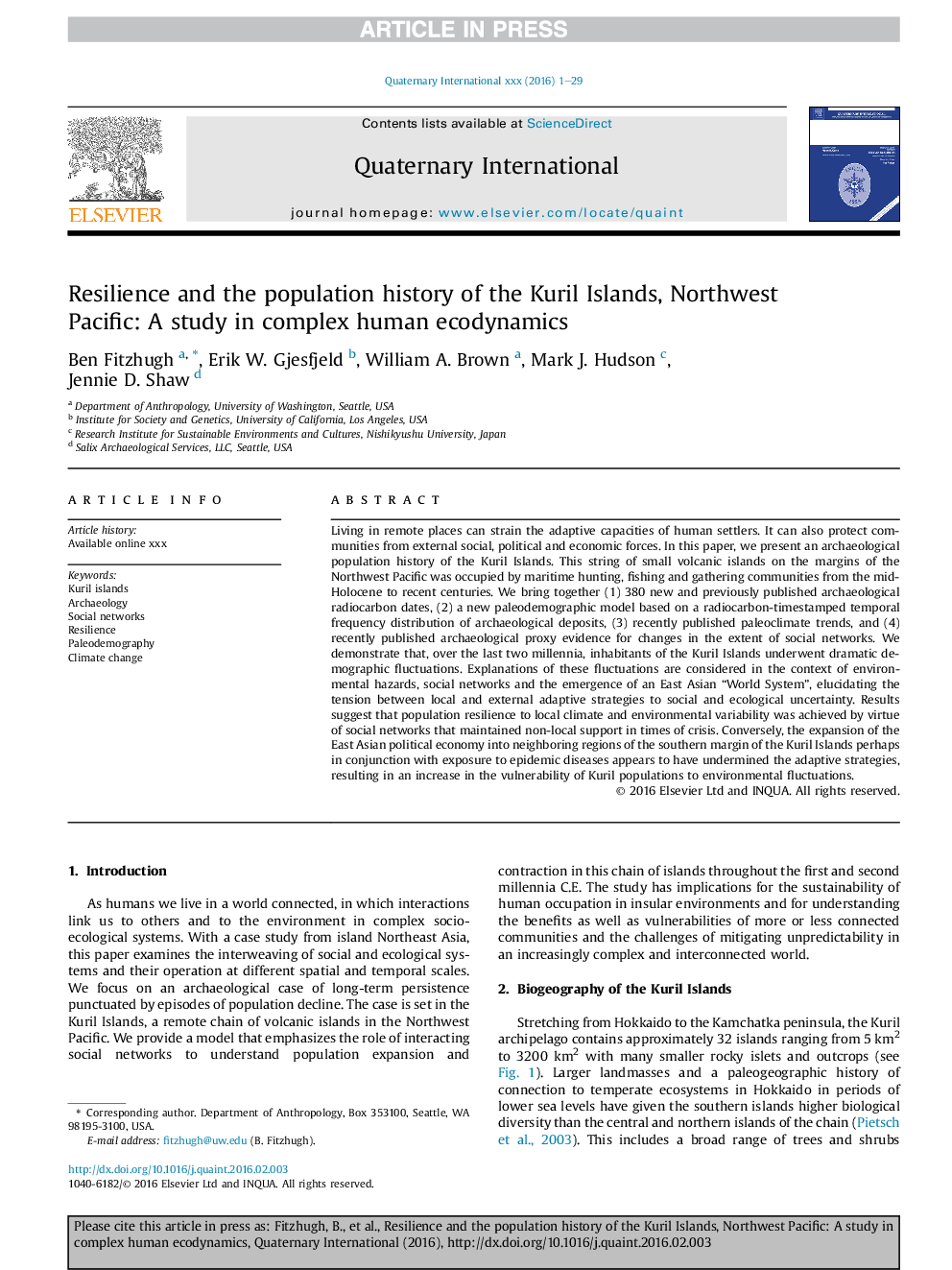| کد مقاله | کد نشریه | سال انتشار | مقاله انگلیسی | نسخه تمام متن |
|---|---|---|---|---|
| 5114094 | 1484088 | 2016 | 29 صفحه PDF | دانلود رایگان |
عنوان انگلیسی مقاله ISI
Resilience and the population history of the Kuril Islands, Northwest Pacific: A study in complex human ecodynamics
ترجمه فارسی عنوان
انعطاف پذیری و تاریخچه جمعیت جزایر کوریل، شمال غربی اقیانوس آرام: مطالعه در اکوادینکامیک پیچیده انسان
دانلود مقاله + سفارش ترجمه
دانلود مقاله ISI انگلیسی
رایگان برای ایرانیان
کلمات کلیدی
جزایر کوریل، باستان شناسی، شبکه های اجتماعی، انعطاف پذیری، پالئودموگرافی، تغییر آب و هوا،
ترجمه چکیده
زندگی در مکان های دور افتاده می تواند ظرفیت های انطباقی مهاجران انسانی را تحت تاثیر قرار دهد. این می تواند جوامع را از نیروهای اجتماعی، سیاسی و اقتصادی خارجی محافظت کند. در این مقاله، ما تاریخ تاریخ باستان شناسی جزایر کوریل را ارائه می کنیم. این رشته جزایر آتشفشانی کوچک در حاشیه شمال غربی اقیانوس آرام توسط شکار دریایی، ماهیگیری و جمع آوری جوامع از اواسط هولوسن تا قرن های اخیر اشغال شده بود. ما با هم (1) 380 جدید و تاریخچه منتشر شده باستان شناس تاریخ رادیو کربن، (2) مدل پیلوودموگرافی جدید بر اساس توزیع فرکانس زمانی رادیو کربن از ذخایر باستان شناسی، (3) اخیرا منتشر شده از رگه های پائولوکلمات، (4) به تازگی منتشر شده باستان شناسی شواهد پروکسی برای تغییر در میزان شبکه های اجتماعی. ما نشان می دهیم که ساکنان جزایر کوریل در طول دو هزاره گذشته متحمل تغییرات جمعیتی شدید شدند. توضیحات این نوسانات در بستر خطرات زیست محیطی، شبکه های اجتماعی و ظهور سیستمی جهانی شرق آسیا در نظر گرفته می شود که کشش تنش بین استراتژی های انطباق محلی و خارجی را به عدم اطمینان اجتماعی و محیطی نشان می دهد. نتایج نشان می دهد که انعطاف پذیری جمعیت به شرایط آب و هوایی محلی و تنوع زیست محیطی به واسطه شبکه های اجتماعی که در زمان بحران حمایت از عدم حمایت محلی می شد، به دست آمد. برعکس، گسترش اقتصاد سیاسی شرق آسیا به مناطق همجوار حاشیه جنوبی جزایر کوریل، احتمالا همراه با قرار گرفتن در معرض بیماری های اپیدمی، به نظر می رسد که استراتژی های تطبیقی را تضعیف کرده و موجب افزایش آسیب پذیری جمعیت کوریل به نوسانات محیطی .
موضوعات مرتبط
مهندسی و علوم پایه
علوم زمین و سیارات
زمین شناسی
چکیده انگلیسی
Living in remote places can strain the adaptive capacities of human settlers. It can also protect communities from external social, political and economic forces. In this paper, we present an archaeological population history of the Kuril Islands. This string of small volcanic islands on the margins of the Northwest Pacific was occupied by maritime hunting, fishing and gathering communities from the mid-Holocene to recent centuries. We bring together (1) 380 new and previously published archaeological radiocarbon dates, (2) a new paleodemographic model based on a radiocarbon-timestamped temporal frequency distribution of archaeological deposits, (3) recently published paleoclimate trends, and (4) recently published archaeological proxy evidence for changes in the extent of social networks. We demonstrate that, over the last two millennia, inhabitants of the Kuril Islands underwent dramatic demographic fluctuations. Explanations of these fluctuations are considered in the context of environmental hazards, social networks and the emergence of an East Asian “World System”, elucidating the tension between local and external adaptive strategies to social and ecological uncertainty. Results suggest that population resilience to local climate and environmental variability was achieved by virtue of social networks that maintained non-local support in times of crisis. Conversely, the expansion of the East Asian political economy into neighboring regions of the southern margin of the Kuril Islands perhaps in conjunction with exposure to epidemic diseases appears to have undermined the adaptive strategies, resulting in an increase in the vulnerability of Kuril populations to environmental fluctuations.
ناشر
Database: Elsevier - ScienceDirect (ساینس دایرکت)
Journal: Quaternary International - Volume 419, 17 October 2016, Pages 165-193
Journal: Quaternary International - Volume 419, 17 October 2016, Pages 165-193
نویسندگان
Ben Fitzhugh, Erik W. Gjesfjeld, William A. Brown, Mark J. Hudson, Jennie D. Shaw,
